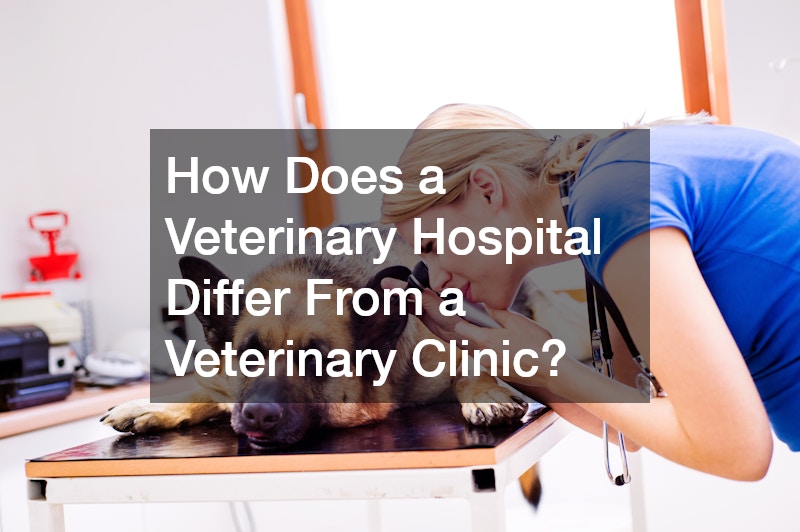Introduction
The question of “how does a veterinary hospital differ from a veterinary clinic” is one that many pet owners often ponder. Each facility serves unique roles in the realm of animal healthcare, catering to different needs and situations. It’s essential to understand these differences to make informed choices for your pet’s health and well-being.
In this article, we will explore the specific characteristics and services that distinguish veterinary hospitals from veterinary clinics. The goal is to provide clarity on when you might need to visit a clinic versus a hospital, much like choosing between a walk-in clinic and an emergency room for human medical needs.
Just as a local personal trainer differs from a full-fledged gym, the scope of services, specialization, and capabilities of veterinary facilities vary significantly. Through this exploration, we aim to equip you with the knowledge necessary to choose the appropriate type of facility for your pet’s healthcare needs.
Scope of Services and Specialization

A veterinary hospital often provides a broader range of services than a veterinary clinic. Think of it as the difference between an urgent care center and a dental clinic, each designed to address different health concerns. Hospitals typically have the capacity to manage more complex medical, surgical, and emergency situations.
Clinics, on the other hand, are more akin to a walk in clinic, focusing on routine and preventive care. They excel in providing vaccinations, wellness exams, and minor treatments, making them the ideal choice for everyday pet healthcare needs. This specialization determines how effectively these facilities can handle various aspects of pet healthcare.
Another aspect to consider is the specialization of staff at these facilities. Veterinary hospitals might employ a diverse team of specialists, enhancing their ability to address a wide range of health issues, similar to how an emergency vet team works in an animal urgent care setting.
Facility Size and Equipment Availability
The size and equipment available at a veterinary hospital significantly contribute to how it differs from a veterinary clinic. Hospitals are generally larger with more advanced diagnostic and surgical tools, akin to a fully equipped gym compared to a small local personal trainer studio. This allows them to perform complex procedures and diagnostics in-house.
Veterinary clinics are usually smaller, focusing on essential equipment necessary for routine check-ups and minor treatments. Their compact nature allows for a more personal setting, where the animal doctor can focus on specific individual needs efficiently. Despite their size, clinics serve a vital role in maintaining general pet health through regular check-ups and preventive care.
The advanced equipment in veterinary hospitals includes imaging devices and extensive laboratory facilities, which are crucial for accurate diagnostics. This equipment allows veterinary hospitals to function much like an emergency vet’s facility would in a high-stakes situation, ready to tackle whatever issue arises with the necessary technology.
Handling Critical and Non-Critical Situations

When it comes to handling both critical and non-critical situations, understanding “how does a veterinary hospital differ from a veterinary clinic” becomes even more pertinent. Veterinary hospitals are equipped to deal with life-threatening emergencies as well as complex surgeries, functioning similarly to an urgent care center for pets.
In non-critical situations, veterinary clinics provide efficient services aimed at maintaining overall health and wellness. Much like a dental clinic ensures oral health, vet clinics ensure your pet’s routine health is up-to-date, preventing potential emergencies. Their ability to manage these less intense scenarios effectively is precisely what makes them a cornerstone in pet healthcare.
This dual capability of managing both extremes makes it crucial to assess a veterinary facility’s services before committing to one. Understanding the facility’s strengths helps you discern where to turn when your pet requires immediate or specialized care, just as you would decide between a walk-in clinic or a hospital for your own health needs.
Hours of Operation and After-Hours Access
One significant difference in how a veterinary hospital differs from a veterinary clinic lies in their hours of operation. Most veterinary hospitals offer extended hours and after-hours services, ensuring your pet receives care even in emergencies. This is aligned with their ability to act as an emergency vets facility when needed.
Veterinary clinics generally operate within standard business hours, focusing on regular appointments and preventive care. While this might limit after-hours accessibility, their role is crucial for routine maintenance of your pet’s health. For sudden emergencies outside these hours, hospitals provide the assurance of immediate and comprehensive care.
Understanding your pet’s healthcare needs, much like how one plans visits to a local personal trainer or a specialist doctor, can help you choose the right facility based on operating hours. This ensures seamless access to the care your pet needs when they need it the most.
Types of Professionals on Staff
The staff composition between a veterinary hospital and a clinic also plays a critical role in how these facilities differ. Hospitals typically have a larger and more diverse team, including specialists in fields such as surgery, cardiology, and internal medicine, which parallels the varied staff found in a comprehensive healthcare facility.
Clinics, on the other hand, often employ general veterinary practitioners who are well-versed in regular pet health concerns. Like a local personal trainer focuses on general fitness, these practitioners concentrate on ensuring your pet’s overall wellness and preventive care.
Having the right professionals on staff allows veterinary hospitals to handle a wide range of medical conditions, from routine check-ups to emergency surgeries. This comprehensive staffing is a key factor in determining how an animal hospital parallels the capabilities of an animal urgent care center.
Depth of Diagnostic and Surgical Capabilities

The diagnostic and surgical capabilities at veterinary hospitals are robust and extensive, making them a go-to for complex medical issues. This sets them apart significantly from vet clinics, where basic diagnostics and minor surgeries are the norms, much like the limited services at a walk in clinic compared to an emergency room.
The advanced technology available in hospitals allows for procedures that include orthopedic, neurosurgery, and advanced imaging, which are vital in diagnosing intricate medical issues. This makes hospitals a reliable choice for handling severe emergencies, much like emergency vets who respond to critical situations swiftly.
Clinics, focused on preventive and wellness care, are limited in surgical capacity but serve excellently for routine diagnostics, vaccinations, and health check-ups. Their role in keeping pets healthy and preventing major issues mirrors the primary care visits in human healthcare.
Patient Intake Process and Scheduling
How a veterinary hospital differs from a veterinary clinic can also be seen in the patient intake process and scheduling. Veterinary hospitals generally operate on an appointment and emergency basis, allowing for immediate attention to critical cases. This flexibility is vital in accommodating pet emergencies as effectively as an urgent care center does.
Clinics, however, tend to work on a more scheduled basis, offering appointments for non-emergency situations and routine wellness checks. This structured environment allows clinics to manage patient flow efficiently, much like a dental clinic scheduling regular check-ups to prevent dental issues.
The intake process in hospitals is often more elaborate, involving specialists as needed, while clinics focus on providing quick and efficient general care. Understanding this difference helps pet owners select the right facility that aligns with their pet’s immediate medical needs.
Approach to Long-Term Health Management
Long-term health management is another area where veterinary hospitals and clinics differ. Hospitals offer comprehensive health plans, addressing both immediate health issues and prolonged care needed for chronic conditions. This holistic approach is similar to a local personal trainer developing a long-term fitness regimen based on individual needs.
Veterinary clinics focus on maintaining health through regular assessments and preventive care, aiming to catch potential issues early. This preventive approach is what makes clinics an essential part of sustaining your pet’s health before conditions become serious. Their methodology is preventive, like routine dental cleanings in a dental clinic, focusing on keeping health issues at bay.
The distinction in approach makes it important to choose appropriately depending on whether your pet requires ongoing management for a chronic condition or regular preventive care. Both play critical roles but cater to different phases of your pet’s health journey.
Environment and Stress Considerations for Pets
The environment in veterinary facilities can significantly affect a pet’s stress levels. Veterinary hospitals, with their bustling environment similar to an emergency vet’s setting, might be more overwhelming for sensitive pets. However, these facilities are equipped to handle critical conditions that require urgent attention.
Clinics often provide a more relaxed and personal atmosphere, much like a one-on-one session with a local personal trainer, focusing on creating a comfortable space for routine check-ups. This can be less intimidating for animals requiring regular care but not emergency interventions.
Understanding your pet’s comfort level and stress tolerance can guide you in choosing the right facility that offers not just medical care but a setting conducive to their well-being. This choice can make frequent visits less daunting and more beneficial for their overall health.
Collaboration With Other Care Providers
Collaboration with other care providers is another distinction between veterinary hospitals and clinics. Hospitals often work closely with specialists and external facilities, coordinating comprehensive care for complex medical conditions. This interconnected approach mirrors how healthcare networks function to provide holistic solutions.
Veterinary clinics might refer patients to hospitals or specialists for advanced care while handling the routine aspects of health in-house. They function similarly to a dental clinic that refers patients to an orthodontist for specialized treatment while managing regular dental health.
This collaborative effort ensures that whether at a hospital or clinic, your pet receives the necessary continuum of care. Understanding the level of coordination ensures you can access all levels of health management as required for your pet’s unique health situation.
Accessibility and Community Presence

The accessibility and presence of veterinary facilities in the community impact how often they are utilized by pet owners. Clinics, like walk in clinics, are often more prevalent and easier to access for routine care, providing convenience for regular visits. Their widespread presence makes them crucial for maintaining pet health within communities.
Veterinary hospitals, while perhaps less numerous, serve as vital hubs for serious medical care akin to urgent care centers in human healthcare. They provide essential services when advanced medical attention is required, ensuring comprehensive care is always within reach.
This greater distribution of clinics enhances their role in everyday pet healthcare, ensuring preventive measures are in place across communities. Hospitals, with their specialized services, complement this accessibility by handling complex and urgent cases.
Cost Structure and Billing Expectations
Cost structure and billing expectations are other major considerations when choosing between a veterinary hospital and a clinic. Hospitals, due to their advanced facilities and staff, typically incur higher costs for procedures and treatments, similar to specialized healthcare services. However, this investment ensures access to comprehensive care and sophisticated diagnostics.
Clinics usually offer more affordable options for routine care, focusing on preventive services and minor treatments. Their billing expectations are manageable, similar to routine dental clinic visits aimed at maintaining oral health without breaking the bank.
Understanding the financial implications of each choice helps pet owners plan and budget for their pet’s healthcare needs. This ensures their furry companions receive the necessary care without unexpected financial stress, allowing for well-rounded pet health management.
Support for Wellness and Preventive Care
The emphasis on wellness and preventive care is integral to understanding “how does a veterinary hospital differ from a veterinary clinic.” Clinics prioritize these elements, ensuring that pets are consistently monitored and cared for to prevent serious health issues from arising.
Hospitals, while capable of providing preventive care, focus more on treating existing conditions and emergencies. Their role is essential when the situation exceeds routine care, much like an emergency vets’ facility during critical events.
This division of labor in healthcare ensures that pets receive tailored care that is appropriate for their current health status. It provides a comprehensive approach to managing pet health, focusing on both prevention and intervention as needed.
Conclusion
In conclusion, understanding how a veterinary hospital differs from a veterinary clinic is crucial for making informed decisions about your pet’s healthcare. From the scope of services to the type of staff and facilities, each aspect plays a role in determining the right choice for varying health needs.
Both facilities complement one another in providing a continuum of care, ranging from routine check-ups at clinics to emergency interventions at hospitals. Similar to choosing between a walk-in clinic and an urgent care center for human health, selecting the appropriate veterinary facility is essential for effective pet healthcare management.
Ultimately, being informed about these differences helps ensure that your pet remains healthy and well-cared for throughout its life, receiving the right care when it’s needed most.
